
Efficient - Engaging - Effective
SCENA Train-the-Trainer Certification
More effective, engaging and efficient training using SCENA
Your training team is under more pressure to work with fewer resources but to deliver better training - how?
Let us work with you to develop your training team, using cutting-edge Research and Evidence which super-charges the effects you get from training.
Less Time? More Content? SCENA delivers.
The power of evidence-based training
High Staff Engagement
Because of the immediate relevance your staff see in your course design and delivery, they are engaged, motivated and Energized during and after the training.
Better Transfer to the Workplace
Because sessions are all driven by your own scenarios, issues and challenges with the people you meet in your work, it has immediate relevance and transfers directly to your day-to-day workplace.
Time Well
Spent
Your teams get many, many opportunities to learn and practice their new skills during 'countless reps' of the target skills, actively learning in every session. There doesn't need to be endless powerpoints!
Measurable Change Happens
With highly targeted new skills, your teams can make measurable changes to their interactions and truly realise your organisation's safety ethos, focussing on dignity and respect, safety and wellbeing.
LINK to UK College of Policing Scenario Based Training evaluation: Link Here
"Can say without question this was one of the most interesting, challenging and enjoyable events I have attended in my career."
- Learning and Development Specialist Metropolitan Police Service, 2021
"I just wanted to drop you an email to thank you for the course. Everyone in my Team thoroughly enjoyed it and are feeling very positive about the way forward. We are now moving our training to a more Scenario training model. Thanks, I certainly got a lot out of it. All round a great course."
- Violence & Aggression Prevention Manager, NHS Board, Scotland - 2022
The differences
The BEnefits
Learning Outcomes
Delivering More Effective Conflict Training. Working together since 2014, Prof Cushion and Dynamis have been leveraging modern research into coaching and learning so that we can make the changes needed to get the very best results from training delivery in Conflict, Personal Safety and Restraint programmes.
Rigorous approaches by trainer/advisors in violence management are increasingly required, and we have found that this methodology can supercharge your training courses, without changing the system of tactics you teach.
More positive outcomes on the front line of your services lies in the HOW we teach, not the WHAT we teach.
Dramatically Improve Learner Engagement. What does the learner need to know, understand, and do? Who is the learner standing in front of the instructor? What coaching behaviour helps me develop that in them? And then, what type of practice environment gives me the environment that I need to develop that learner?
Implement Efficient Whole-Task Practice. Practice needs to become a progression – an increasingly complex version of the whole. You’re looking to create learning through the practices you design into your sessions. You want your learners to recognize cues, and things that are happening as a scenario unfolds, so that the learning that happens through your scenarios becomes part of the design of courses and training.
Safely Incorporate Scenario Training. Putting learners under pressure is important to replicate real-work situations, but pressure comes in different ways. Pressure can be peer observation. Pressure can be against the clock. Pressure can be with a video camera on. There’s a whole range of ways for creating pressure that isn’t full-intensity scenario-replication.
Visit the College of Policing's own report on adopting scenario-based training here.
The document evaluates a new two-day scenario-based conflict management training program that was piloted with over 2,000 officers in Avon and Somerset Police. Here are the key benefits of the training:
1. **Reduction in Use of Force**: The training led to significant reductions in the overall use of force, particularly in officers going "hands-on," meaning they were less likely to resort to physical force. This also translated into an estimated 1,200 fewer use-of-force incidents over 12 months.
2. **Improved Public Safety**: There was a reduction in the number of people injured as a result of police use of force. The likelihood of injury during these incidents dropped significantly, contributing to better public safety outcomes.
3. **Officer Safety Maintained**: Despite the reduction in use of force, there was no significant increase in injuries to officers during incidents, indicating that officer safety was not compromised.
4. **Increased Officer Confidence**: Officers reported a significant increase in their confidence in using almost all use-of-force tactics after training. This confidence was maintained even three months after the training.
5. **High Officer Satisfaction**: Officers were significantly more satisfied with the new training compared to previous training methods. They also rated the quality of the new training higher.
6. **Effective Training Delivery**: The scenario-based approach and the personalized feedback provided during the training helped officers refine their conflict management skills in a realistic and supportive environment.
7. **No Negative Impact on Other Policing Activities**: The training did not result in officers disengaging from other policing activities, such as responding to calls or making arrests, which indicates that it effectively enhanced conflict management without diminishing other duties.
Overall, the training was found to be effective in reducing the use of force and improving public safety while maintaining officer safety and boosting confidence in managing conflict.
Our Director of Training, Gerard O’Dea, and Professor Chris Cushion worked with a number of experienced conflict and physical intervention trainers from NHS boards around Scotland to introduce them to the SCENA Scenario-Driven Training Approach in early March 2022.
The team - already competently teaching a variety of approaches to tactics including Maybo, GSA, Functional Edge, S.P.E.A.R. and even some in-house-developed methods - were brought together by a common desire to improve their training provision.
Their common goals were to:
By leveraging the body of research-informed knowledge available, the SCENA course encourages trainers to make their session design more contextual, to increase the rate of practice of the target skillsets and to advance learner decision-making at the same time as the knowledge and skills in their programme.
SCENA contributes its knowledge-base to produce a noticeably different way of delivering training, compared to the normally ‘accepted’ methods where a slide-deck of content is central to the delivery, and where skills are taught, they are taught ‘from the manual’ and in a manner which is more focussed on the assessment in the classroom rather than operational .
In learning terms, performance refers to changes in behaviour which which only lasts until the learner leaves the classroom, rather than the achievement of relatively long-term changes in staff behaviour (learning) which will ‘move the needle’ in how they deal with conflict when they are back in the ward.
One trainer, after experiencing a 1-hour model lesson on the first day of the training, expressed the following:
“I am shocked by how much content we just covered,
and how much we were able to practice as learners.”
The attending trainers were tasked with increasingly complex training session design and delivery. Having worked together to decide what the core scenarios for their learners are, the trainers were then tasked with designing and then developing a scenario-based lesson plan which reflected the learning outcomes they wanted to meet in the session.
A core outcome of the course is that conflict management, personal safety, risk assessment, care planning and restrictive interventions learning outcomes are ‘meshed’ rather than treated separately - in silos. This approach requires the trainers to re-configure their training courses to match operational situations, rather than in a rigid by-the-book manner. The approach soon separates the creative, knowledgeable and progressive trainers from those who prefer to have prescribed, slide-based training plans - sparking paradigm-shifting conversations in the SCENA training room!
Here’s what the experienced and professional trainers on this CPD / Development course said:
“We are now moving our training to a more Scenario training model. This course exceeded my expectations and the course tutors were excellent“
Violence and Aggression Adviser/Trainer, NHS Scotland Board
“This trainer development course exceeded my expectations. It was excellent, mainly due to the fact that the evidence suggests (and I am convinced) that this approach will help information retention for our learners. As training providers we need to make sure the learners come first to make sure that overall safety in the areas they work in is increased. The scenario driven approach also creates a safer environment for NHS staff as they have experience in working under pressure -the same pressure they will experience during work.”
Health and Safety Advisor for Prevention and managment of Violence and Aggression, NHS Scotland Board
“Thank you for this course. You have provided a well thought out training package which does not force change on the curriculum but changes the way in which you teach it - aiding better skill retention. What was great to see what was being told; that you can get even novice learners very quickly into scenarios, is exactly what we did on the course... Very useful to see trainers practicing what they preach.“
Health and Safety Advisor for Prevention and managment of Violence and Aggression, NHS Scotland Board
“I just wanted to drop you an email to thank you for the course. Everyone in my Team thoroughly enjoyed it and are feeling very positive about the way forward. Thanks, I certainly got a lot out of it. All round a great course.”
Violence & Aggression Prevention Manager, NHS Scotland Board
To learn more about how to create more efficient, engaging and effective training, using a scenario-driven approach, please visit the SCENA webpage at [https://www.dynamis.training/trainers/scena/] and by all means, get in touch for a discussion about how this approach can help your team.
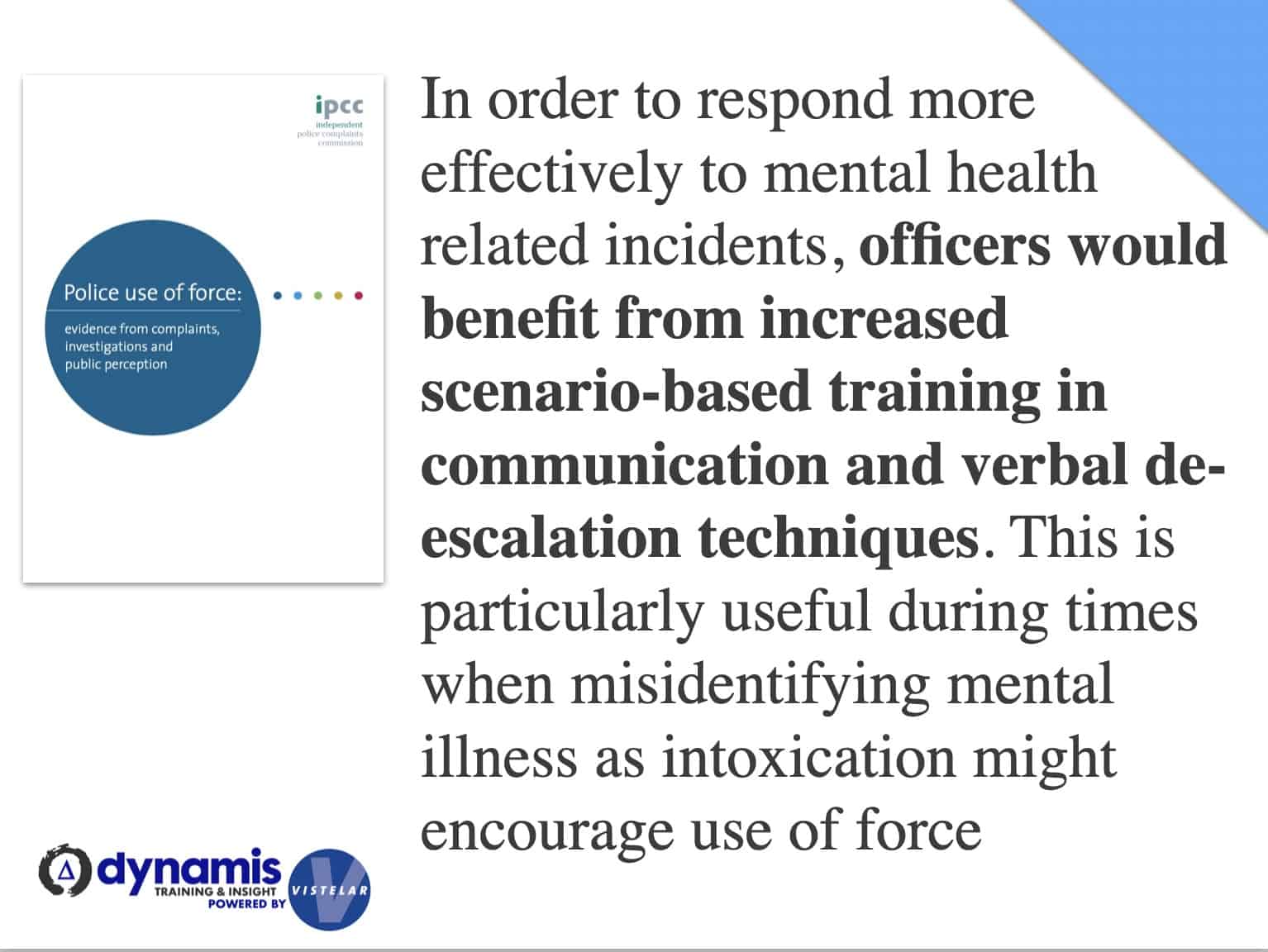
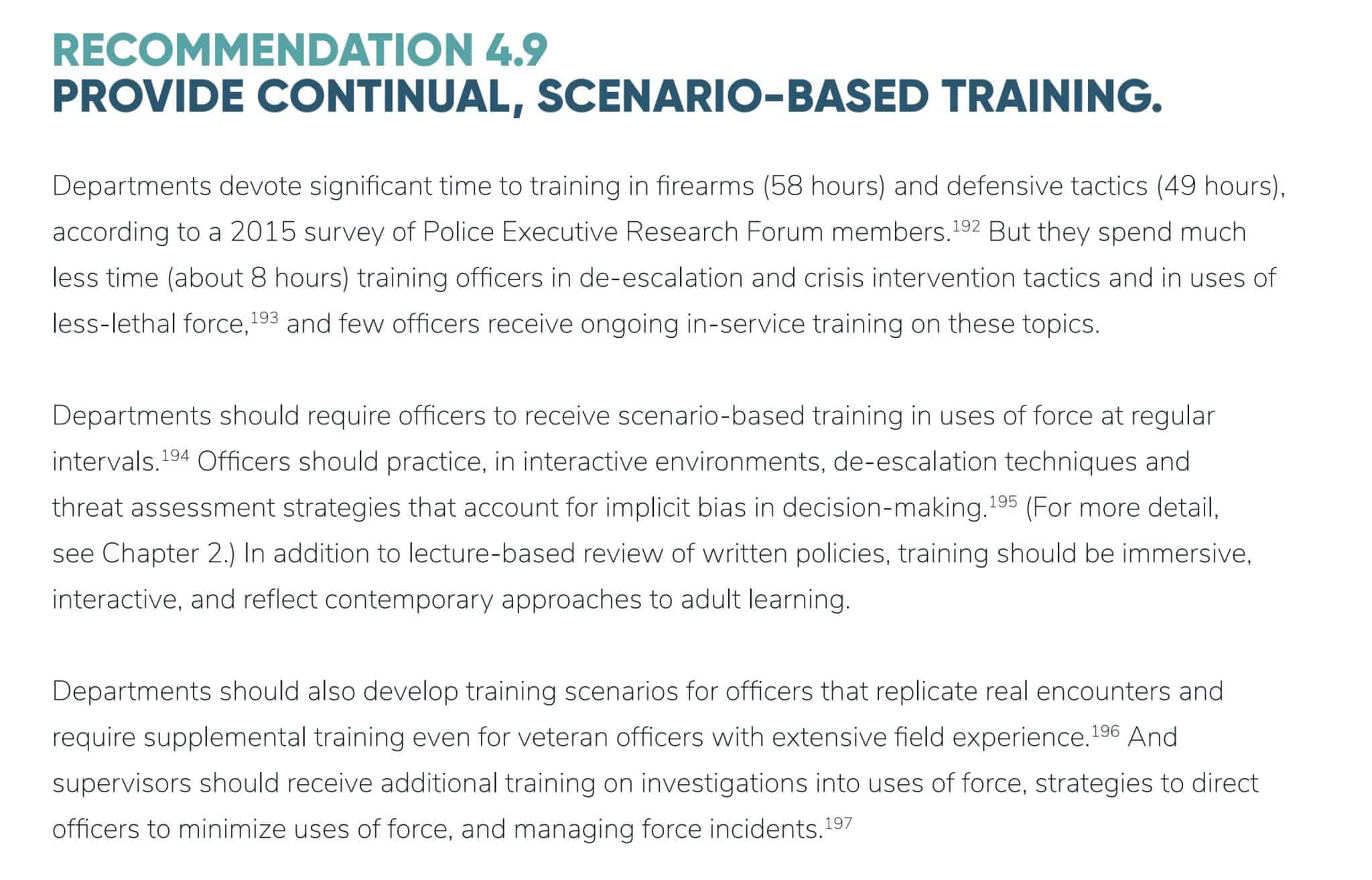
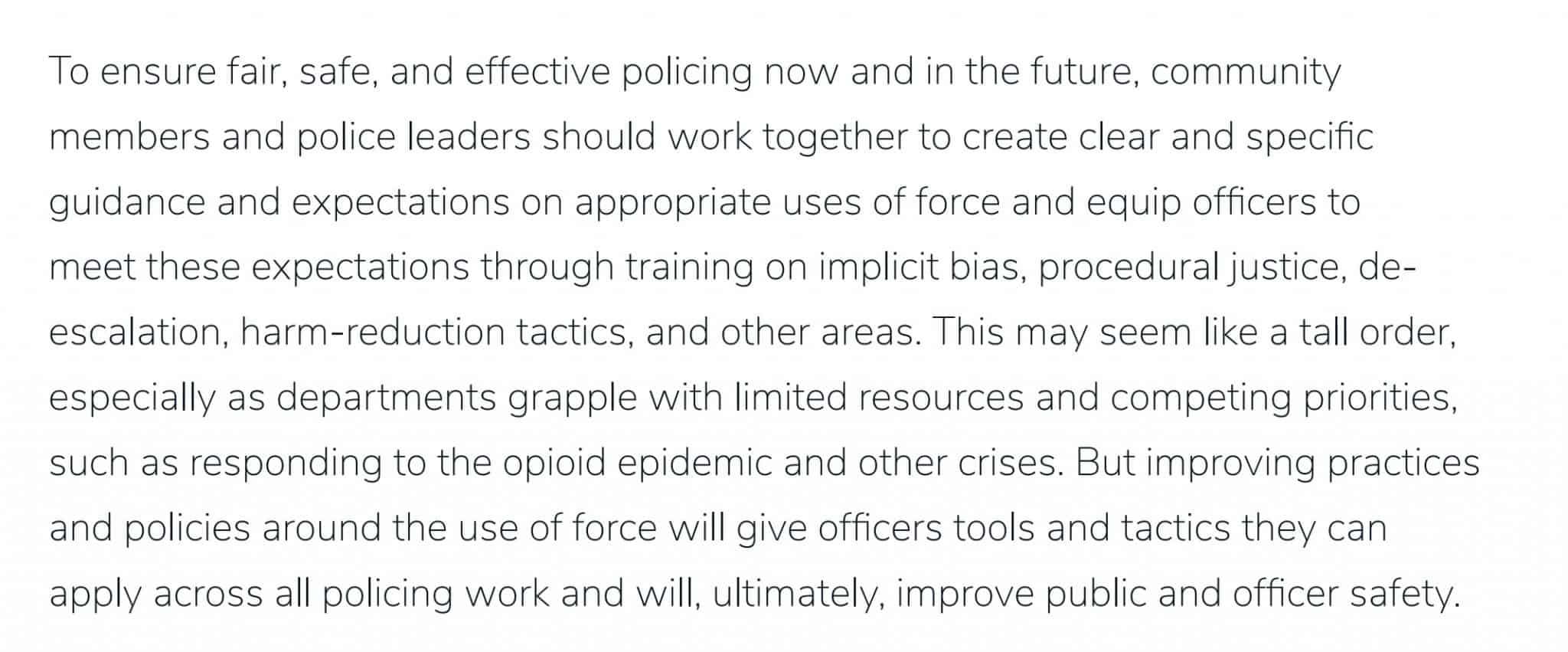
Recent research has suggested that Officer Safety Training in some forces may not be adequately preparing officers for the heightened risks of their work in the current climate, where assault on police are increasing.
Since 2006, I have audited a host of personal safety and restraint training programs, some of which have dusty histories that go back over 50 years with connections to asian martial arts, and some of which are more modern methods that have come to prominence only in the last couple of decades. Every trainer I have met is convinced that there are "better tactics" and usually that their tactics are the best.
The focus on ‘tactics’ and ‘techniques’ is understandable (and it is even fun sometimes!) however as I hope to explain, the key difference may be in the teaching and NOT in the technical.
BACKGROUND TO 'OST'
There is an assault on a police officer roughly every 22 minutes in the UK.
When such an assault happens, officers rely on their Officer Safety Training (OST) to survive and resolve the incident. In this sense it has some similarities to the Breakaway training our NHS clinical staff receive, and the self-defence training that our Prison Service staff receive, in that its purpose is to prepare at-risk workers for the occupational use of force in their workplace. When the training includes the control and restraint of violently resisting subjects, it may be referred to as Arrest and Self-Defence Skills (ASDS).
I also learned that although most police officers attend officer safety training on an annual basis, the nature, design, content, delivery and crucially the effectiveness of this training is not very well understood. Research into the effectiveness of officer safety training is sparse, however in recent years those who have cast their eyes on this part of police training have been looking at it from a few new and different angles.
CONSEQUENCES OF POOR TRAINING EFFECTIVENESS
Let’s pause for a moment to consider the importance of OST and ASDS training in terms of the police officer, the police services and the public they serve. A quick Google search for police use of force will render story after story of tragic incidents where often vulnerable people have died in police custody where the arrest, control and restraint methods used during their final moments are put under intense scrutiny.
“What the research tells us is that highly skilled police officers tend to use force very effectively. They've got a wider range of techniques to use. And they generally use less force in confrontational situations. However, less skilled officers are more likely to use more force and use force inappropriately. The reason for this is often because of fear.” --Prof. Chris Cushion
I always look at these incidents as multiple tragedies: the officers involved face personal, legal, emotional and organisational stress in addition to the loss, heart-ache, grief and frustration of the relatives of those who lose their lives.
Arguably, beyond the cost and return on investment of providing this training from an organisational point of view, officers and the public deserve to have confidence that OST and ASDS training is achieving its aims: greater safety, less risk and consistency in the appropriate use of force.
THE WHAT-WE-TEACH PROBLEM
Early in my career, I was escorted into a room at a national-level agency and shown a single, security-restricted copy of the ‘Self-Defence’ training programme which was being taught to at-risk staff. My sense of anticipation before opening that document caused my heart to race. You can only imagine my disappointment, however, when I discovered that the ‘security restricted’ material was no better than was available to anyone who can get their hands on the still on-sale 1960s-era Japanese Karate books on the Martial Arts shelf at your local bookstore!
The truth is, there are probably as many different approaches and opinions about the physical management of confrontations as there are people interested in them.
In fact my friend and mentor Gary Klugiewicz from Vistelar, a global consulting and training company focussing on the entire spectrum of human conflict, has often repeated the following: “defensive tactics are a matter of opinion”
THE HOW-WE-TEACH SOLUTION?
In 2014 I met researcher and coaching expert Prof. Chris Cushion, who has for thirty years specialised in coaching and trainer-education. We started a conversation about the efficacy of using a training methodology in which the tactics were based on behavioural, observable effects of violence and the instinctive responses involved in kinetic high-stress violent encounters. We had many conversations and spent more than a few hours in the training hall exploring the issues.
Chris was already experienced in martial arts prior to turning his professional eye on OST and ASDS. One of his first hypotheses that caught my eye was that, while so many of us trainers are wrapped up in the merits of individual tactics for physical intervention, personal safety and restraint, perhaps as a sector we were missing something that he believed that was glaringly obvious.
Perhaps, he said, it was HOW we taught and not what we taught that would make the difference to our learners when, while single-crewed and responding to a call out, they needed to perform tactics robustly and at a high level of skill, with very little notice or preparation, in the context of their working day.
“Obviously, there's huge pressure, financial pressures, resources in training. And how can we do this in a short amount of time and for less money. The purpose of this research overall is try to understand, well what's being done. Is it effective? Does it produce highly skilled officers?” -- Prof. Chris Cushion
We have collaborated extensively to address what may be one of the biggest problems in our industry (learner performance under real-world pressure), while also pointing out the fact that maybe, just maybe, there were already evidence-based and well researched models from the field of coaching, learning and performance which we could lean on to improve the results we were getting with our learners.
While I set out on a professional journey to change the way I and my team of trainers at Dynamis would plan and design and deliver our training in the education, health, social care, hospital security sectors based on his advice, Chris focused his attention on what was happening in the police services and attempted to discover how officer safety training was being delivered to arguably the most at-risk group of workers in the UK in terms of physical assault risk.
His feeling is that the degree of contextualisation, the practice design and the coaching behaviours which shape the learning environment has a large effect on learning, real world performance and therefore true officer safety outcomes.
The results of his study into officer safety training at one police service were published in a Journal of Policing article, published by Oxford University press.
Although limited to one police service’s training provision, some of his findings from this study were :
A key issue that he noted was that the trainers themselves had low self-awareness, which happens to be (I learned) extremely common among coaches across the entire domain of coaching and instruction. What this means is that coaching and training staff may have certain beliefs about the effectiveness of the program they are teaching which do not match the reported experiences of their learners or the confidence of those learners to persevere in high-risk encounters.
“This is the reality: Violence is chaotic. It's pressure. It's chaos. It's aggressive and very surprising. The training, however, is isolated, low pressure, very predictable, and very linear. The similarity between the training and what officers have to face on the street? It is very different.” -- Prof. Chris Cushion
There were many other notable points made in the study. Overall, what the study suggests is that the learners - our frontline police officers - who need to use and rely on their personal safety training on a daily basis, may have a low level of confidence that the training they are receiving is effective, and crucially it is possible that their trainers may have little awareness of this.
Simulation in nursing and midwifery education - World Health Organisation
"Simulation has been used widely in the clinical training of health-care students and professionals. It is a valuable strategy for teaching, learning and evaluating clinical skills at different levels of nursing and midwifery education: undergraduate, postgraduate and lifelong education (Park et al., 2016; Martins, 2017).
Simulation has a positive impact on students, educators, and the individuals, groups and communities they care for, as well as on education and health organizations. The principal aims of simulation as a teaching method are to improve quality of care and ensure patient safety.
The WHO document Transforming and scaling up health professionals’ education and training (WHO, 2013) strongly recommends the use of simulation.
A large proportion of nursing and midwifery education curricula worldwide is dedicated to the acquisition of clinical skills. At the beginning of the learning period in clinical settings, students should be able to develop safe and timely evidence-based interventions without being interrupted by supervisors due to technical errors that may jeopardize patients’ and students’ safety. In clinical practice with actual patients, students should be self-confident and feel that others trust them; they should feel capable of performing tasks without errors and be confident that the supervisor and other team members believe in their abilities.
From an ethical perspective, invasive procedures should not be taught or practised on real people; instead, trainees should be able to train in simulated, controlled and safe environments, allowing them to make errors and learn from them with no harmful consequences to any person. This ensures absolute respect for human rights by protecting patients’ dignity and guarantees the quality of nursing care, even during health professionals’ learning processes.
Simulation as an active pedagogical strategy helps students to consolidate and value knowledge, develop technical and relational skills, and create rules and habits for thinking and reflection, thereby contributing to the training of competent professionals. In addition, the process is developed within a safe environment for students, teachers and patients (Martins, 2017).
Despite international recommendations to include simulation in nursing and midwifery education and the evidence of its benefits, many institutions have difficulties in integrating simulation methods in their curricula. Reasons for this include the lack of national incentives to transform and scale up nursing and midwifery education, available funding, existing facilities, curriculum management, and the readiness and disposition of school faculties and management.
The way that simulation is integrated in the curriculum varies widely across institutions and countries. Simulation can be integrated into several course units, into theoretical course units as a practical component, or into clinical training course units; simulated practice can also comprise a course unit. Students have the opportunity through some curricula to train in different techniques in different scenarios, while in others, students remain mostly as observers. Simulation can be used almost entirely for the purpose of learning and training specific techniques or can focus on developing more comprehensive and cross-cutting skills (such as patient and team communication, teamwork, decision- making, management of adverse events and leadership) by gradually incorporating techniques in complete scenarios of increasing complexity."
Simulation in nursing and midwifery education - W.H.O. - https://www.euro.who.int/__data/assets/pdf_file/0011/383807/snme-report-eng.pdf?ua=1
Professor Chris Cushion discusses, in seven short videos, how established evidence and research helps you design and deliver more engaging, effective and efficient training courses in Conflict and Physical Interventions.
We use SCENA to deliver satisfaction
What our customers are saying:
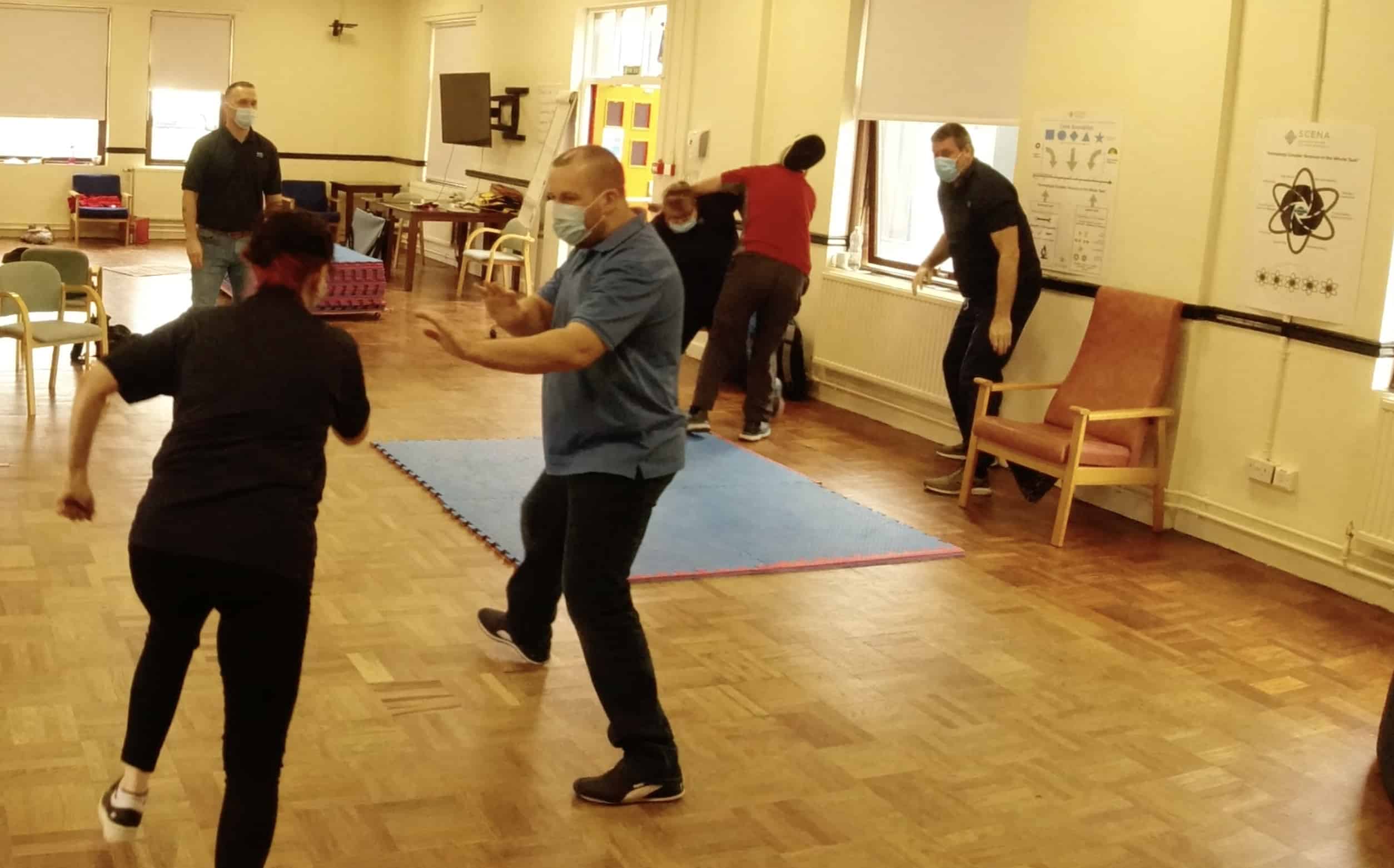
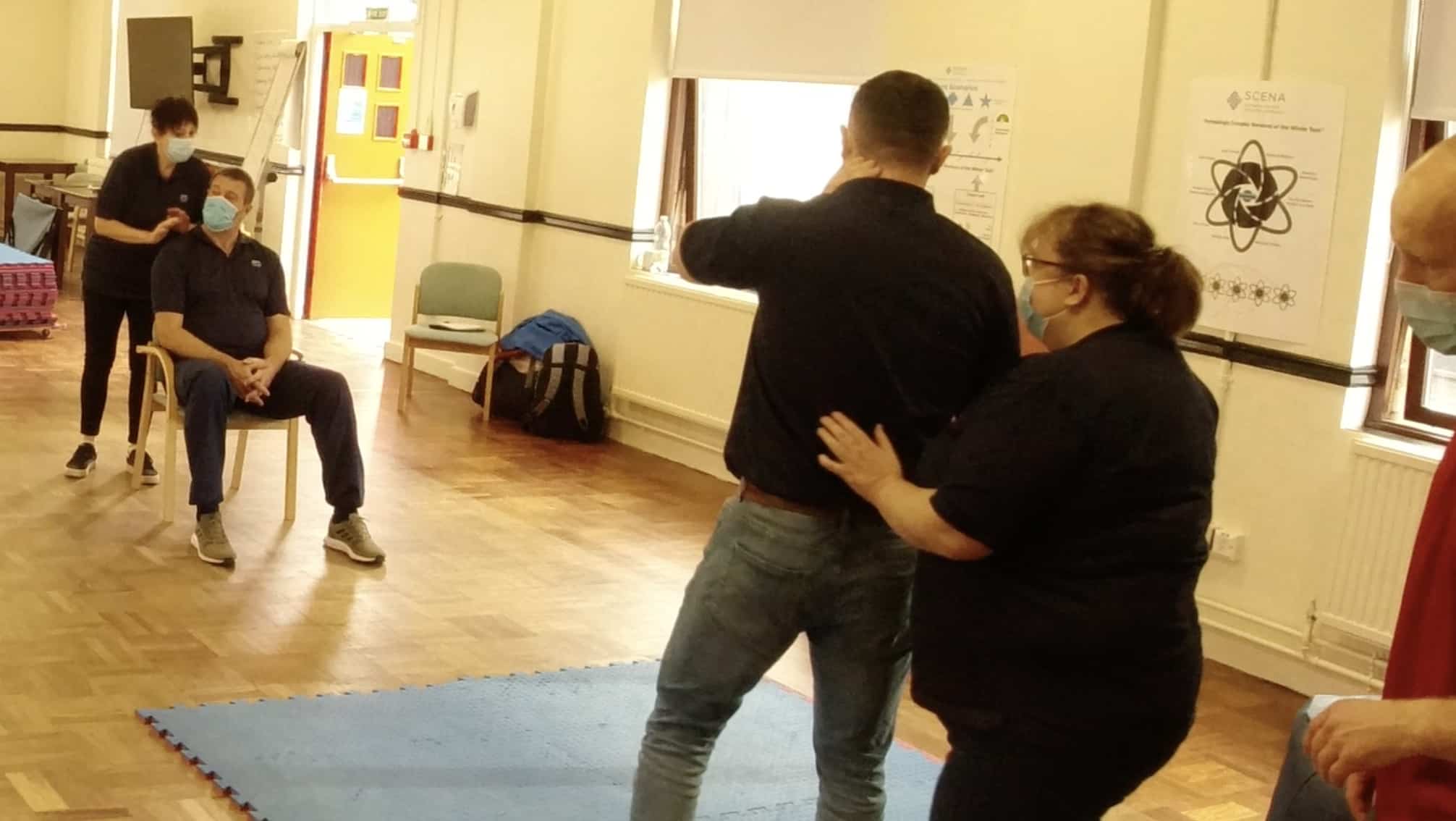
"Context is so important in how NHS staff manage violent and aggressive behaviours. Decisions made under pressure are different than those made without, we need to create this pressure. If learners cannot see the how or why the techniques will help them, they will disengage. The current style of teaching is not fully encompassing self-awareness, dynamic risk assessing and decision making under pressure that is a constant expectation of staff in their wards and areas. Scenario driven training closes the context gap, staff leave training more confident and safer at being able to prevent and manage violence and aggression."
NHS V&A Advisor, Scotland
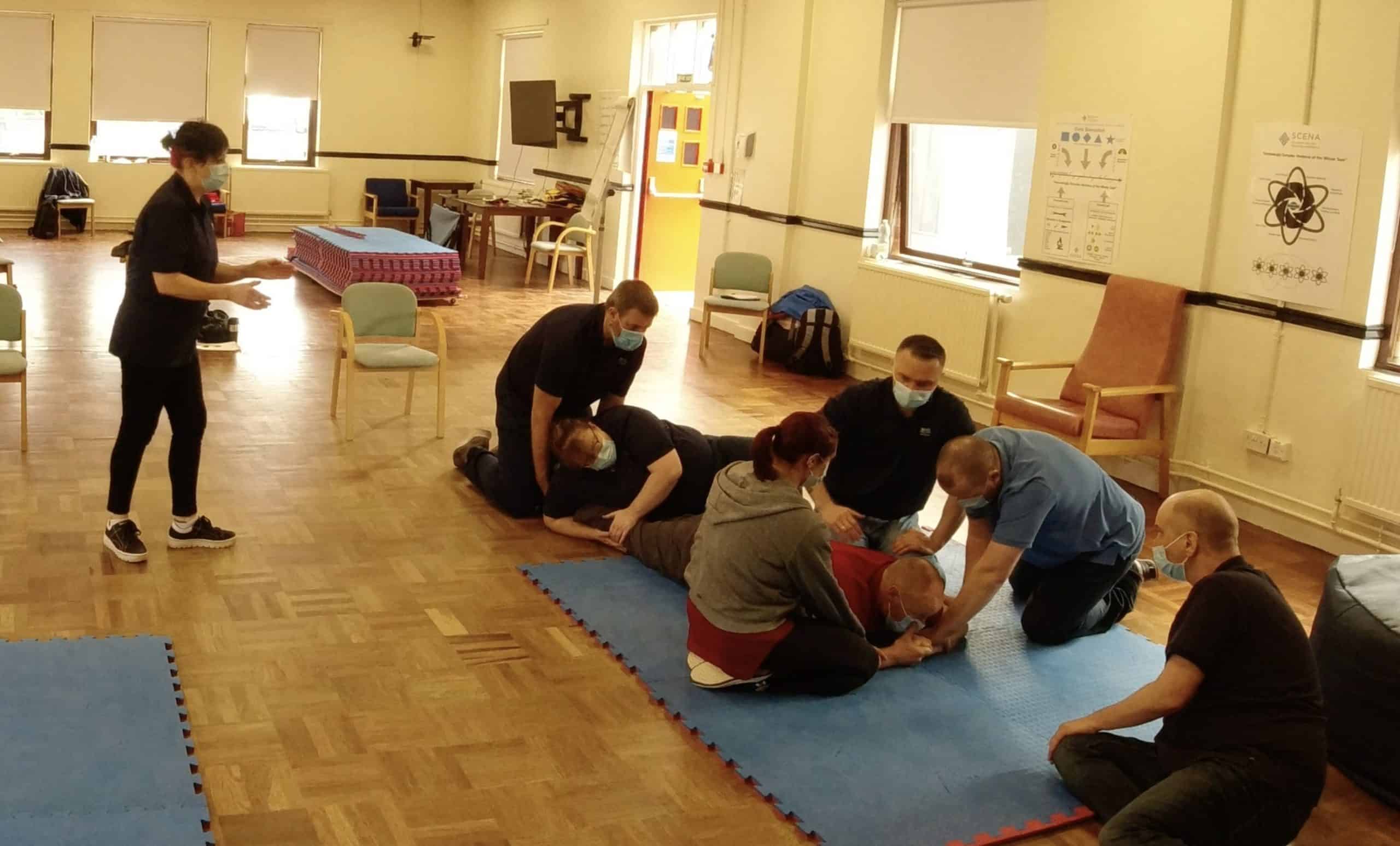
Our Process for Working with You
Our Partners and Accreditation

MEMBER OF THE INSTITUTE OF
CONFLICT MANAGEMENT
Dynamis is a Quality Award Centre with the ICM, a recognised accrediting body in the U.K. for workplace training in the prevention and management of workplace violence.

Five-star Endorsement from Expert Panel
Dynamis has achieved the highest possible level of endorsement from an industry-leading panel of experts - Safety Without Compromise.
When: SCENA Train-the-Trainer Foundation Course takes 3-5 Days of in-person training, plus project work back in your workplace..
Who: Trainers coming on our courses are usually experienced professionals in their own right, with training experience in the Conflict Management, Customer Service, Personal Safety or Physical Interventions domain. They hold Level 3 Qualifications in physical intervention, conflict management and breakaway/self-protection and sometimes already hold Level 3 Teaching qualifications.
Where: Training is held at Loughborough University or another high-quality training venue chosen to match your needs.
How: Your Coach Development Team deliver this course using a mix of pre-course learning, lecture/presentation, Q&A, teaching practice and scenario rehearsal.
100%
You are fully protected by our 100% Satisfaction-Guarantee. If you are not fully satisfied by the training we deliver for your team, just let us know and we'll send you a prompt refund.
Gerard O'Dea